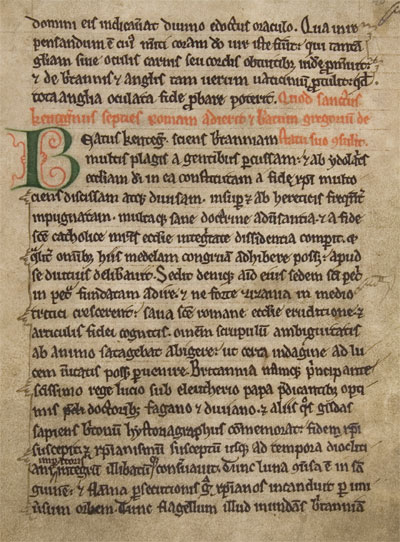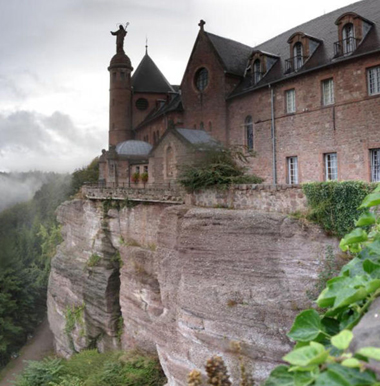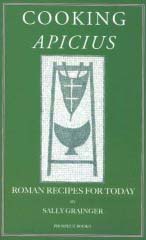Category — Rare Manuscripts
The Book of Deer – Celtic Illuminations and the Oldest Known Gaelic from Scotland
 One of the most interesting Celtic manuscripts is The Book of Deer. It dates from the 10th century and is the earliest manuscript from an area of Scotland known as “former Pictland”. The Book of Deer is considered particularily important for the notes written in Gaelic in the margins of the original text. The Gaelic “scribbles” are the earliest record of written Gaelic from Scotland. From The Book of Deer Project web page:
One of the most interesting Celtic manuscripts is The Book of Deer. It dates from the 10th century and is the earliest manuscript from an area of Scotland known as “former Pictland”. The Book of Deer is considered particularily important for the notes written in Gaelic in the margins of the original text. The Gaelic “scribbles” are the earliest record of written Gaelic from Scotland. From The Book of Deer Project web page:
The Book of Deer is one of Scotland’s most important manuscripts. It is a small (54mm x 107mm) Gospel Book, now housed in Cambridge University Library. Before c. 1100 it was apparently in the possession of the early Columban monastery at Old Deer in north-east Aberdeenshire. This monastery has otherwise left no trace of its existence. A Cistercian Abbey was founded nearby in 1219. The Book of Deer came into the ownership of Cambridge University Library in 1715, when the library of the Bishop of Ely and Norwich was presented to the former by George I. Before that, the Book of Deer may have been in the possession of Dr Gale, High master of St Paul’s School (1672-97). The stages by which it moved from the North East of Scotland to the South of England are by no means clear. Even Cambridge University Library was unaware of its significance until it was ‘discovered’ in 1860 by the then librarian, Henry Bradshaw.
More information and images are available on The Book of Deer web page.
March 31, 2007 Comments Off on The Book of Deer – Celtic Illuminations and the Oldest Known Gaelic from Scotland
The Return of the Vita of St. Kentigern to Glasgow – A Continuing Mystery
 A book depicting the life of St. Kentigern, a sixth century saint, was commissioned in the latter part of the 12th century. The finished manuscript was kept in the Glasgow Catherdral and mysteriously disappeared 400 years ago. From the Medieval Sourcebook, here is a bit of the history of the celtic manuscript that vanished:
A book depicting the life of St. Kentigern, a sixth century saint, was commissioned in the latter part of the 12th century. The finished manuscript was kept in the Glasgow Catherdral and mysteriously disappeared 400 years ago. From the Medieval Sourcebook, here is a bit of the history of the celtic manuscript that vanished:
The oldest extant source for Kentigern is the fragmentary Life of Saint Kentigern. This life consists of a preface and eight chapters. The author is only describes himself as a cleric of St. Kentigern who had travelled a great deal, and the preface states that the life was composed at the request of Herbert, bishop of Glasgow from 1147 to 1164. The anonymous author said that he found his material for the Life of Saint Kentigern in a little book of his miracles and from oral tradition.
This fragmentary life was used at Glasgow for about 30 years. At that time a new life was written by Jocelyn, a monk of Furness Abbey in northern Lancashire. This life was written at the request of Bishop Jocelyn, who was Bishop of Glasgow from 1175 to 1199. Jocelyn, the author, was at Down in Ireland in 1185, and so it is likely that he wrote his Life of Saint Kentigern sometime before then, perhaps about 1180. Jocelyn also states that he used a little book, written in the Scottic style, as a source for his life, as well as the life already at Glasgow and oral tradition.
From the Evening Times:
It’s a long-running whodunnit that’s baffled investigators for 400 years – who stole Glagow’s most historic book? The Vita St Kentigern – the story of the city’s patron saint – disappeared from its home at Glasgow Cathedral four centuries ago. The culprit has never been traced, far less brought to justice. Now, finally, the book has returned …
Approximately 300 years ago, a copy of the original manuscript was acquired by Archbishop Marsh of Dublin and it was held safely in that library until two years ago when the book was scanned and used to create four new copies of the ancient hagiography. Thus, after 400 years the story of the life of St. Kentigern has returned to Glasgow, Scotland. A page of that manuscript is shown below.

March 21, 2007 2 Comments
The Mysterious Book Thefts from the 8th-Century Convent of Mont Sainte-Odile

The thefts of hundreds of priceless historic books from the 8th-century convent of Mont Sainte-Odile including dozens of 15th century illuminated manuscripts is a great mystery story. I love books and who doesn’t love intrigue especially a locked room mystery in an 8th century monastery perched on the edge of a peak in Alsace, France. It’s an irresistible combination.
From the Guardian in May, 2002:
The 8th-century convent of Mont Sainte-Odile towers over the picturesque small town of Saverne in the foothills of the Vosges mountains. One of the most popular attractions in Alsace, tens of thousands of people a year tour its abbey, church, chapel and cloisters, dine in its hotel and restaurants and admire the stunning view across the plain to the river Rhine and, beyond, the Black Forest.
Among them, from August 2000, was a curiously well-informed thief. From that date, a succession of immensely valuable works, including precious early religious texts and several dozen heavy 15th-century illuminated manuscripts bound in wood and leather, began disappearing from the abbey’s first-floor library. Police were flummoxed.
Mont Sainte Odile has an exciting history dating from the 2nd century until the present. In 1992, the mountain was struck by an airplane. The monastery, however, is named for an event from that supposedly happened in the 7th century:
In the 7th century Etichon, a merovingian duke, resided in Obernai. His wife Bereswinde, niece of Saint Léger, bishop of Autun and King’s councellor, gave birth to a daughter who was blind . Odile was brought up in Balma Burgundy (Baume-les -Dames) recovers the sight on the day of her baptism.
How did someone steal more than 1000 books from a locked library in an ancient monastery on top of a 2500 foot mountain in France? From the prosecutor as told in the Guardian:
“It was one of those frustrating but also rather thrilling cases,” Madeleine Simoncello, the Saverne public prosecutor, said yesterday. “Quite extraordinary items were vanishing, sometimes singly, sometimes by the dozen. By last weekend over 1,000 had gone, yet the room wasn’t even open to the public and as far as we knew nobody could get in.”
Like a movie, the police went in the library and thumped on the walls and floor searching for a secret passage. One officer, pushing on a plank of wood at the back of a bookcase discovered a secret room. The thief was entering the monastery with tour groups and quietly making his way to a corridor that led to the secret room. From there, he entered the library and quietly chose his books. He piled them neatly on the table in the secret room and came back in the evening to collect his prize. But, with a hidden camera installed, the thief was captured with a suitcase full of priceless medieval manuscripts. The young man had not tried to sell any of the books. Every missing manuscript was found in his home. He wanted them for his own enjoyment. One part of the mystery remains: How did he know about the secret room? From the prosecutor:
“It seems it is mentioned in a highly specialised review,” she said. “This particular issue dealt with some of the oddities of Mont Sainte-Odile. The suspect, who quite clearly adored the abbey, came across it in Strasbourg University library.” The man was one of very, very few people to know of the passageway’s existence, she said.
While no one could approve of stealing these books, it must have been tremendously thrilling. Imagine coming across the information about the passage and the secret room. You would wonder if it really existed. Then, making the trip to the monastery and finding the room and realizing you’re the only one there who knows about it would be too much to bear. Such temptation would be hard to resist.
[tags]Mont Sainte-Odile, 7th century, 8th century, medieval manuscripts, illuminated manuscripts, mystery book thief[/tags]
December 7, 2006 Comments Off on The Mysterious Book Thefts from the 8th-Century Convent of Mont Sainte-Odile
A Manuscript from the Dark Ages – The Apicius Cookbook
 If you watched CBS Sunday Morning today you saw a segment entitled “The Art of the Cookbook” that featured “The Apicus”. There are two known copies of “The Apicius”. The Vatican holds the oldest copy. The manuscipt shown on CBS is from the 9th century and is owned the The New York Academy of Medicine. The original book was is credited to Marcus Gavius Apiciusin who was a notorius Roman foodie from the first century. Most historians, however, believe he is not the actual author of this only surviving Roman cookbook containing 500 recipes.
If you watched CBS Sunday Morning today you saw a segment entitled “The Art of the Cookbook” that featured “The Apicus”. There are two known copies of “The Apicius”. The Vatican holds the oldest copy. The manuscipt shown on CBS is from the 9th century and is owned the The New York Academy of Medicine. The original book was is credited to Marcus Gavius Apiciusin who was a notorius Roman foodie from the first century. Most historians, however, believe he is not the actual author of this only surviving Roman cookbook containing 500 recipes.
There have been many modern translations of “The Apicius” over the years. This site offers a list of the common herbs and seasonings described in the book. Perhaps the best source on the internet on this book is available from the University of Chicago web site where selections from a 1936 text are available. “Cooking Apicus: Roman Recipes for Today” is a well reviewed lay text. If you’re a hard core history food enthusiast you might want to find a copy of “Apicius, a Critical Edition With an Introduction And English Translation”
. Either way, this manuscript is another example of how the monks of medieval Europe preserved history.
[tags]CBS News Sunday Morning, Apicius, 10th century manuscipt, Roman Cookbook[/tags]
November 19, 2006 Comments Off on A Manuscript from the Dark Ages – The Apicius Cookbook

